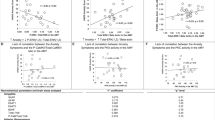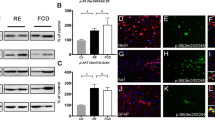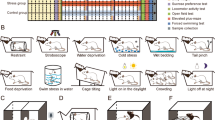Abstract
There is considerable interest in examining the genes that may contribute to anxiety. We examined the function of ERK/MAPK in the acquisition of conditioned fear, as measured by fear-potentiated startle (FPS) in mice as a model for anticipatory anxiety in humans. We characterized the following for the first time in the mouse: (1) the expression of the ERK/MAPK signaling pathway components at the protein level in the lateral amygdala (LA); (2) the time course of activation of phospho-activated MAPK in the LA after fear conditioning; (3) if pharmacological inhibition of pMAPK could modulate the acquisition of FPS; (4) the cell-type specificity of pMAPK in the LA after fear conditioning. Using western blot and immunohistochemistry techniques and injecting the MEK inhibitor U0126 in the LA, we showed the following: (1) both MEK1/MEK2 and ERK1/ERK2 were co-expressed in the LA of the adult mouse brain; (2) there is a peak of pMAPK at 60 min after fear conditioning; (3) the ERK/MAPK signaling pathway activation is essential for the acquisition of an FPS response; (4) at 60 min, the pMAPK are exclusively neuronal and not glial. These results emphasize the importance of this signaling pathway in the acquisition of conditioned fear in the mouse. Given the widely held view that conditioned fear models the essential aspects of anxiety disorders, the results confirm the ERK/MAPK signaling pathway as a molecular target for the treatment of anxiety disorders in the clinic.
Similar content being viewed by others
Log in or create a free account to read this content
Gain free access to this article, as well as selected content from this journal and more on nature.com
or
References
Asan E, Yilmazer-Hanke DM, Eliava M, Hantsch M, Lesch KP, Schmitt A (2005). The corticotropin-releasing factor (CRF)-system and monoaminergic afferents in the central amygdala: investigations in different mouse strains and comparison with the rat. Neuroscience 131: 953–967.
Baas JM, Grillon C, Bocker KB, Brack AA, Morgan III CA, Kenemans JL et al (2002). Benzodiazepines have no effect on fear-potentiated startle in humans. Psychopharmacology (Berl) 161: 233–247.
Baekelandt V, Claeys A, Cherepanov P, De Clercq E, De Strooper B, Nuttin B et al (2000). DNA-dependent protein kinase is not required for efficient lentivirus integration. J Virol 74: 11278–11285.
Bauer EP, Schafe GE, LeDoux JE (2002). NMDA receptors and L-type voltage-gated calcium channels contribute to long-term potentiation and different components of fear memory formation in the lateral amygdala. J Neurosci 22: 5239–5249.
Bitsios P, Philpott A, Langley RW, Bradshaw CM, Szabadi E (1999). Comparison of the effects of diazepam on the fear-potentiated startle reflex and the fear-inhibited light reflex in man. J Psychopharmacol 13: 226–234.
Blair HT, Schafe GE, Bauer EP, Rodrigues SM, LeDoux JE (2001). Synaptic plasticity in the lateral amygdala: a cellular hypothesis of fear conditioning. Learn Mem 8: 229–242.
Chen CY, Shyu AB (1995). AU-rich elements: characterization and importance in mRNA degradation. Trends Biochem Sci 20: 465–470.
Coyle JT, Duman RS (2003). Finding the intracellular signaling pathways affected by mood disorder treatments. Neuron 38: 157–160.
Cryan JF, Holmes A (2005). The ascent of mouse: advances in modelling human depression and anxiety. Nat Rev Drug Discov 4: 775–790.
Davis M (1992). The role of the amygdala in fear and anxiety. Annu Rev Neurosci 15: 353–375.
Di Benedetto B, Hitz C, Holter SM, Kuhn R, Vogt Weisenhorn DM, Wurst W (2007). Differential mRNA distribution of components of the ERK/MAPK signalling cascade in the adult mouse brain. J Comp Neurol 500: 542–556.
Falls WA (2002). Fear-potentiated startle in mice. Curr Protoc Neurosci 8.11B.1–8.11B.16.
Falls WA, Carlson S, Turner JG, Willott JF (1997). Fear-potentiated startle in two strains of inbred mice. Behav Neurosci 111: 855–861.
Falls WA, Kogan JH, Silva AJ, Willott JF, Carlson S, Turner JG (2000). Fear-potentiated startle, but not prepulse inhibition of startle is impaired in CREBalphadelta−/− mutant mice. Behav Neurosci 114: 998–1004.
Ge W, Yang XJ, Zhang Z, Wang HK, Shen W, Deng QD et al (2006). Long-term potentiation of neuron-glia synapses mediated by Ca2+-permeable AMPA receptors. Science 312: 1533–1537.
Gegelashvili G, Schousboe A (1997). High affinity glutamate transporters: regulation of expression and activity. Mol Pharmacol 52: 6–15.
Grillon C, Ameli R, Goddard A, Woods SW, Davis M (1994). Baseline and fear-potentiated startle in panic disorder patients. Biol Psychiatry 35: 431–439.
Grillon C, Ameli R, Woods SW, Merikangas K, Davis M (1991). Fear-potentiated startle in humans: effects of anticipatory anxiety on the acoustic blink reflex. Psychophysiology 28: 588–595.
Gundersen HJ, Bagger P, Bendtsen TF, Evans SM, Korbo L, Marcussen N et al (1988). The new stereological tools: disector, fractionator, nucleator and point sampled intercepts and their use in pathological research and diagnosis. APMIS 96: 857–881.
Heldt S, Sundin V, Willott JF, Falls WA (2000). Posttraining lesions of the amygdala interfere with fear-potentiated startle to both visual and auditory conditioned stimuli in C57BL/6J mice. Behav Neurosci 114: 749–759.
Jardim MC, Nogueira RL, Graeff FG, Nunes-de-Souza RL (1999). Evaluation of the elevated T-maze as an animal model of anxiety in the mouse. Brain Res Bull 48: 407–411.
Kanai Y (1997). Family of neutral and acidic amino acid transporters: molecular biology, physiology and medical implications. Curr Opin Cell Biol 9: 565–572.
Kaufman J, Charney D (2000). Comorbidity of mood and anxiety disorders. Depress Anxiety 12 (Suppl 1): 69–76.
LaBar KS, Gatenby JC, Gore JC, LeDoux JE, Phelps EA (1998). Human amygdala activation during conditioned fear acquisition and extinction: a mixed-trial fMRI study. Neuron 20: 937–945.
Mitchell P, Tollervey D (2000). mRNA stability in eukaryotes. Curr Opin Genet Dev 10: 193–198.
Nicholls D, Attwell D (1990). The release and uptake of excitatory amino acids. Trends Pharmacol Sci 11: 462–468.
Nishiyama H, Knopfel T, Endo S, Itohara S (2002). Glial protein S100B modulates long-term neuronal synaptic plasticity. Proc Natl Acad Sci USA 99: 4037–4042.
Parpura V, Haydon PG (2000). Physiological astrocytic calcium levels stimulate glutamate release to modulate adjacent neurons. Proc Natl Acad Sci USA 97: 8629–8634.
Paul S, Olausson P, Venkitaramani DV, Ruchkina I, Moran TD, Tronson N et al (2007). The striatal-enriched protein tyrosine phosphatase gates long-term potentiation and fear memory in the lateral amygdala. Biol Psychiatry 61: 1049–1061.
Paxinos G, Franklin KBJ (2001). The Mouse Brain in Stereotaxic Coordinates, 2nd edn. Academic Press: San Diego, CA, USA.
Phelps EA, O'Connor KJ, Gatenby JC, Gore JC, Grillon C, Davis M (2001). Activation of the left amygdala to a cognitive representation of fear. Nat Neurosci 4: 437–441.
Rattiner LM, Davis M, French CT, Ressler KJ (2004). Brain-derived neurotrophic factor and tyrosine kinase receptor B involvement in amygdala-dependent fear conditioning. J Neurosci 24: 4796–4806.
Risbrough VB, Brodkin JD, Geyer MA (2003). GABA-A and 5-HT1A receptor agonists block expression of fear-potentiated startle in mice. Neuropsychopharmacology 28: 654–663.
Roberson ED, English JD, Adams JP, Selcher JC, Kondratick C, Sweatt JD (1999). The mitogen-activated protein kinase cascade couples PKA and PKC to cAMP response element binding protein phosphorylation in area CA1 of hippocampus. J Neurosci 19: 4337–4348.
Rothstein JD, Dykes-Hoberg M, Pardo CA, Bristol LA, Jin L, Kuncl RW et al (1996). Knockout of glutamate transporters reveals a major role for astroglial transport in excitotoxicity and clearance of glutamate. Neuron 16: 675–686.
Schafe GE, Atkins CM, Swank MW, Bauer EP, Sweatt JD, LeDoux JE (2000). Activation of ERK/MAP kinase in the amygdala is required for memory consolidation of pavlovian fear conditioning. J Neurosci 20: 8177–8187.
Schafe GE, Nadel NV, Sullivan GM, Harris A, LeDoux JE (1999). Memory consolidation for contextual and auditory fear conditioning is dependent on protein synthesis, PKA, and MAP kinase. Learn Mem 6: 97–110.
Schafe GE, Nader K, Blair HT, LeDoux JE (2001). Memory consolidation of Pavlovian fear conditioning: a cellular and molecular perspective. Trends Neurosci 24: 540–546.
Seifert G, Schilling K, Steinhauser C (2006). Astrocyte dysfunction in neurological disorders: a molecular perspective. Nat Rev Neurosci 7: 194–206.
Tanaka K, Watase K, Manabe T, Yamada K, Watanabe M, Takahashi K et al (1997). Epilepsy and exacerbation of brain injury in mice lacking the glutamate transporter GLT-1. Science 276: 1699–1702.
Thomas KL, Hunt SP (1993). The regional distribution of extracellularly regulated kinase-1 and -2 messenger RNA in the adult rat central nervous system. Neuroscience 56: 741–757.
Todd KJ, Serrano A, Lacaille JC, Robitaille R (2006). Glial cells in synaptic plasticity. J Physiol Paris 99: 75–83.
Valjent E, Pages C, Hervé D, Girault JA, Caboche J (2004). Addictive and non-addictive drugs induce distinct and specific patterns of ERK activation in mouse brain. Eur J Neurosci 19: 1826–1836.
Walker DL, Davis M (2002). Quantifying fear potentiated startle using absolute versus proportional increase scoring methods: implications for the neurocircuitry of fear and anxiety. Psychopharmacology (Berl) 164: 318–328.
Whishaw IQ, Metz GA, Kolb B, Pellis SM (2001). Accelerated nervous system development contributes to behavioral efficiency in the laboratory mouse: a behavioral review and theoretical proposal. Dev Psychobiol 39: 151–170.
Acknowledgements
BDB is particularly indebted with Dr Vera Pedersen for her generous support with surgery and histological analysis in the first phases of the pharmacological studies; and with Johanna Neumann for helping with the IHC during the analysis of the time course of activated pMAPK. This work has been funded by the Federal Ministry of Education and Research (BMBF) in the framework of the National Genome Research Network (NGFN), Förderkennzeichen 01GR430, and by the European Union (FP6, EUMODIC, LSHG-CT-2006-037188). We are responsible for the contents of this publication.
BDB performed the experiments, participated in the design of the study and wrote the manuscript. MK gave her contribution in the statistical analysis and with the FPS experiments. DMVW participated in the supervision of the histological procedures. WAF gave his contribution in the establishment of the FPS procedures. SMH and WW participated in the design and coordination of the study. All authors read and approved the final manuscript.
Author information
Authors and Affiliations
Corresponding authors
Additional information
DISCLOSURE/CONFLICT OF INTEREST
The authors declare no competing financial interest.
Supplementary Information accompanies the paper on the Neuropsychopharmacology website (http://www.nature.com/npp)
Supplementary information
Rights and permissions
About this article
Cite this article
Di Benedetto, B., Kallnik, M., Weisenhorn, D. et al. Activation of ERK/MAPK in the Lateral Amygdala of the Mouse is Required for Acquisition of a Fear-Potentiated Startle response. Neuropsychopharmacol 34, 356–366 (2009). https://doi.org/10.1038/npp.2008.57
Received:
Revised:
Accepted:
Published:
Issue date:
DOI: https://doi.org/10.1038/npp.2008.57
Keywords
This article is cited by
-
Comparative dynamics of MAPK/ERK signalling components and immediate early genes in the hippocampus and amygdala following contextual fear conditioning and retrieval
Brain Structure and Function (2014)
-
The role of PKC signaling in CRF-induced modulation of startle
Psychopharmacology (2013)
-
The structure of Pavlovian fear conditioning in the amygdala
Brain Structure and Function (2013)
-
Reduction of fear-potentiated startle by benzodiazepines in C57BL/6J mice
Psychopharmacology (2011)



